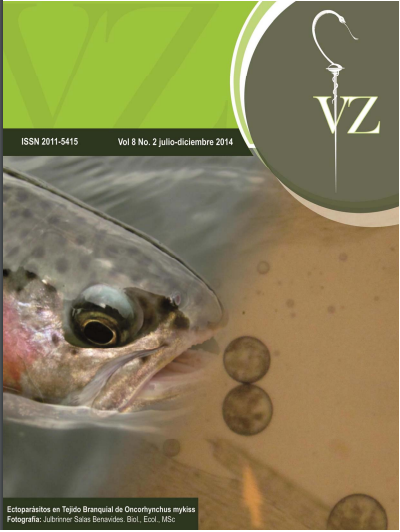Authors
Abstract
ABSTRACT: The study of canine seizure is relevant in research as a natural model of epilepsy in small animal clinic, because of its high frequency in the neurology service. This work adapted the “Ictal Phenomenology. Glossary of Descriptive Ictal Terminology” appendix in the clinic of canine patients with epileptic crisis to classify its phenomenology and recognize a symptomatology zone. The Phenomenology and the symptomatology zone analysis suggest that canines in epileptic crisis present brain areas sensible of generating abnormal neuronal activity, specifically; the high frequency of the phenomenological motor group defined a parietal-frontal lobe localization.
References
Berendt, M.; Gram, L. Epilepsy and seizure classification in 63 dogs: Areappraisal of veterinary epilepsy terminology. J. Vet Intern Med., v.13, n.1, p.14‐20, 1999.
Berendt, M.;Gredal, H.;Alving, J. Characteristic and phenomenology of epileptic partial seizures in dogs: Similarities with human seizure semiology. pilepsy Research., v. 61, p. 167‐173, 2004.
Berg, A.T.; Berkovic, S.F.; Brodie, M.J.; Buchhalter, J.; Cross, J.H.; Van Emde, B.W. et al. Revised terminology and concepts for organization of seizures and epilepsies: Report of the ILAE Commission on Classification and Terminology, 2005‐2009. Epilepsia, v.51, n.4, p. 676‐85, 2010.
Blume‐Chair, W.T.;Luders, H.O.; Mizrahi, E. et al. Glossary of descriptive terminology for Ictal Semiology: Report of the ILAE Task Force on Classification and Terminology. ILAE Commission Report. Epilepsia, v.42, n.9, p. 1212‐1218, 2001.
Commision on Classification and Terminology of the International LeagueAgainst Epilepsy. Proposal for revised classification of epilepsies and epileptic syndromes. Epilepsia, v.2, p. 389‐399, 1989.
Commission on Classification and Terminology of the International League Against Epilepsy. Proposal for revised clinical and electroencephalographic classification of epileptic seizures. Epilepsia, v.22, p. 489‐501, 1981.
Costa, J.C.; Palmini, A.; Yacubian, E.M.T.; Cavalheiro, E.A. Fundamentos Neurobiológicos das Epilepsias. São Paulo, Brasil: Editorial Lemus, 2013. p. 163‐172.
Chandler, K. Canine epilepsy: What can we learn from human seizure disorders? Veterinary Journal, v.172, p. 207‐217, 2006.
Ekenstedt, K.J.; Oberbauer, A. Inherited Epilepsy in Dogs. Topics in Companion Animal Medicine, v.28, p. 51‐58, 2013.
Engel, J.A. Proposed diagnostic scheme for people with epileptic seizures and with Epilepsy: Report of the ILAE task force on classification and terminology. ILAE commission report. Epilepsia, v.42, n.6, p. 796‐803, 2001.
Engel, J. ILAE Classification of epilepsy syndromes. Epilepsy Research, v.70, p. 5‐10, 2006.
Fischer, R. The new ILAE classification. Epilepsia, v.51, n.4,p. 713‐724, 2010.
Hammer, H.M.; Wyllie, E.; Luders, H.O. et al. Symptomatology of epileptic seizures in the first three years of life. Epilepsia, v.40, p. 837‐844, 1999.
Graeff, L.F.C.;Vahia, K.B. Perfil clínico e epidemiológico de cães epilépticos atendidos no hospital veterinarioda UFRRJ. Rev Bras Ciências Veterinarias, v.14, n.1, p. 51‐55, 2007.
Licht, B.G.;Licht, M.H.;Harper, K.M. et al. Clinical presentations of naturally occurring canine seizures: Similarities to human seizures. Epilepsy Behavior, v.3, p. 460‐470, 2002.
Lorenz, M.; Coates, J.; Kent, M.Handbook of Veterinary Neurology. Amsterdam, Holland: Elsevier Saunders Inc., 2011. p. 5‐6.
Mariani, CL. Terminology and Classification of Seizures and Epilepsy in Veterinary Patients. Topics in Companion Animal Medicine, v.28, p. 34‐41, 2013.
Merlis, J.K. Proposal for an international classification of the epilepsies. Epilepsia, v.11, p. 114‐119, 1970.
Moore, S.A Clinical and Diagnostic Approach to the Patient whit Seizures. Topics in Companions Animal Medicine, v.28, p. 46‐50, 2013.
Morita, T.; Shimada, A.; Takeuchi, T.; Hikasa, Y.; Sawada, M.; Ohiwa, S. Clinico neuropathologic findings of familial frontal lobe epilepsy in Shetland heepdogs. Can J Vet Res., v. 66, p. 35‐41, 2002.
Packer, R.M.A.; Berendt, M.; Bhatt, S.; Charalambous, M.; Cizinauskas, S.; De Risio, L. Inter‐observer agreement of canine and feline paroxysmal event semiology and classification by veterinary neurology specialists and non‐specialists. BMC Veterinary Research, p. 11‐39, 2015.
Pákozdy, Á.; Leschnik, M.; Sarchahi, A.A.; Tichy, A.G.; Thalhammer, J.G. Clinical comparision of primary versus secondary epilepsy in 125 cats. Journal of Feline Medicine and Surgery,v. 12, p.910‐916,2010.
Potschka, H.; Fischer, A.;Ruden, E.L.V.;Hulsmeyer, V.; Baumgartner, W. Canine epilepsy as a translational model? Epilepsy,v.54, n. 4,p. 571‐579, 2013.
Rosenow, F.;Luders, H. Presurgical evaluation of epilepsy. Brain,v.124,p.1683‐1700, 2001.
Thomas, W.B. Idiopathic Epilepsy in Dogs and Cats: Small Animal Practice. Veterinary Clinics of North America, v.40, n.1, p.161‐179, 2010.
World Health Organization. Manual of the International statistical classification of disease, injuries and causes of death. Based on the recommendation of the Eighth Conference, Geneva, 1955. Geneva, Switzerland: WHO, 1967.

 PDF (Español)
PDF (Español)
 FLIP
FLIP










